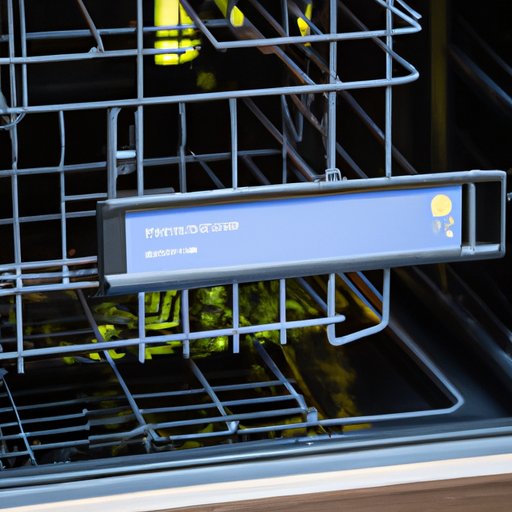
Introduction
Do you find yourself staring at your dishwasher wondering where to start? Do you struggle with getting your dishes clean every time you run the cycle? Using a dishwasher can seem intimidating at first, but with the right guidance, it can make your life easier. This article provides a comprehensive guide to help you use a dishwasher effectively.
Step-by-Step Guide: How to Operate a Dishwasher
One of the biggest benefits of using a dishwasher is the convenience of not having to wash dishes by hand. Knowing how to load and unload your dishwasher properly can save you time and hassle. Here’s a quick guide:
Load your dishwasher:
- Remove any leftover food from your dishes and rinse them if necessary.
- Place plates in the bottom rack and maximize space by alternating the direction of the plates.
- Place bowls and cups on the top rack, upside down to prevent water from collecting.
- Utensils should be placed in the designated utensil holder.
Select the appropriate program:
Almost all dishwashers come with several wash options, such as heavy-duty, normal, delicate, or quick wash. Some models even have specific programs for cleaning dishes with tough stains. Choose the right program according to the level of soiling on your dishes.
Use detergent effectively:
Using the right detergent can make all the difference when it comes to getting your dishes clean. Powder and liquid detergents are both effective, but many people prefer dishwasher pods for convenience. Place the detergent according to the manufacturer’s recommendation and never overload the dispenser.
Maintenance tips:
Cleaning and regular maintenance are vital to ensure your dishwasher continues to function efficiently. Some tips include:
- Inspect the dishwasher hoses and valves regularly to ensure there are no splits or gaps in the line.
- Clean the dishwasher once every month by running an empty cycle with detergent and vinegar.
- Remove the dishwasher drain and clean any gunk that has collected.
Troubleshooting Common Issues
Leakage, bad odor, and clogs are some of the most common dishwasher issues you’ll likely encounter. Here are some tips on how to quickly solve these problems:
Leakage:
- Check that the hoses and valves are properly connected and tightened.
- Inspect the door gasket for any damage or gaps.
- Ensure the dishwasher is leveled properly as an uneven dishwasher can cause leaks.
Bad Odor:
- Run an empty cycle with baking soda for a clean deodorizing effect.
- Regularly clean the dishwasher filter to remove food particle build-up and other debris that can emit odors.
- Clean the dishwasher interior with a vinegar solution to eliminate stubborn odors.
Clogging:
- Check the drainage hose for any kinks and that the drain is clear. Use a snake to loosen blockages.
- Clean the dishwasher’s filter to allow water to flow easily.
Comparison of Best Dishwasher Models on the Market
Choosing the right dishwasher for your needs can seem overwhelming. Here are some of the best dishwashers on the market:
Bosch 500 Series Dishwasher:
The Bosch 500 Series Dishwasher is sleek, quiet, and easy to use. Its 44-decibel rating ensures that it doesn’t disrupt your evening conversations. Above all, its innovative drying system uses high heat to soak up moisture and leave dishes completely dry, making it a top contender.
KitchenAid KDPE234GPS Dishwasher:
The KitchenAid KDPE234GPS dishwasher offers adjustable racks and large capacity for a reasonable price. It’s also equipped with a soil sensor that adjusts cycle time and water consumption based on the level of soiling on your dishes.
LG Signature Dishwasher:
The LG Signature Dishwasher is a great choice if you’re looking for a high-end dishwasher that offers the best technology. Its advanced features include TurboSteam, a powerful steam cleaning system that eliminates bacteria and other harmful particles.
Eco-Friendly Tips for Using Your Dishwasher
If you’re among the growing number of consumers looking to reduce your carbon footprint, here are some tips:
Use energy-saving settings:
Most dishwashers come with energy-saving settings you can use to save on your utility bill. Choosing the eco-friendly option or running your dishwasher during off-peak hours can help save money and the environment.
Eco-friendly detergents:
Choose eco-friendly detergent options that don’t contain harmful chemicals. They are made of natural ingredients and are biodegradable, protecting the environment from pollutants. They may be costlier than regular detergent, but worth the investment in the long term.
Reduce water usage:
You can save water by running your dishwasher only when it’s fully loaded. This reduces the number of cycles and conserves water. Pre-rinsing dishes can also waste water, so a quick scrape of leftover food should suffice.
Maintenance Tips for Your Dishwasher
To get the most out of your dishwasher, it’s important to maintain it properly:
- Regularly clean the dishwasher to prevent buildup of bacteria and mold.
- Check all the hoses and connections to ensure they are functioning properly and replace them as necessary.
- Replace any damaged or broken parts of the dishwasher.
Conclusion
Using a dishwasher can be a life-changing experience, especially when you know how to use it effectively. This comprehensive guide highlighted the key steps you should follow when operating your dishwasher, common issues, the best dishwasher models on the market, eco-friendly tips, and maintenance tips. Follow these tips to ensure that your dishwasher remains efficient for a long time.
Final Tips:
Always read the manufacturer’s instruction manual before operating the dishwasher. Make sure you never overload your dishwasher, as this can damage the machine. Finally, enjoy the convenience and have a great time cooking, eating, and gathering, leaving the dishes to the dishwasher to get them sparkling clean.




